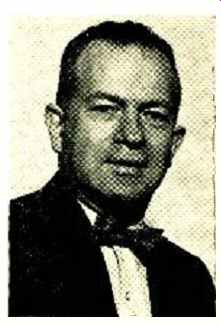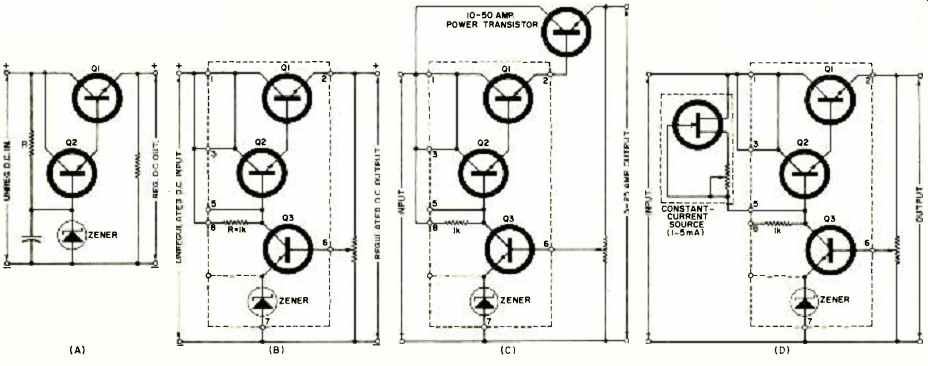(source: Electronics World, Apr. 1968)

By A.H. SEIDMAN /Contributing Editor
The author, Assoc. Professor of Electrical Engineering at Pratt Institute, received his B.E.E. Cum Laude from CCNY in 1951 and attended Columbia and Hofstra Universities (M.A. in Physics, 1958). His areas of interest are solid-state electronics and computer logic. He is the coauthor of "Semiconductor Fundamentals: Devices and Circuits" and is currently at work on a new book, "Electronic Circuit Analysis" which will be published in the very near future.
The integrated circuit has now invaded the power-supply industry. IC voltage regulators, some with current ratings of 2 amperes and load regulation up to 0.05 percent, offer new design opportunities.
THE integrated circuit, already well-established in digital-circuit applications and a growing factor in analog systems, has made its debut in power supplies. Typical of the industry, the five firms in Table 1 are marketing monolithic and hybrid IC voltage regulators in TO-5 and other small-size packages. Based on proven discrete designs, these units are capable of delivering up to 2 amperes at regulated voltages as high as 48 volts with 2 percent or better load regulation. Prices range from approximately $6 to $60 each in small quantities. With additional external components, the capabilities of some of these devices can be extended to current ratings as high as 25 amperes and voltage regulation on the order of 0.025 percent.
The advantages of integrated circuit regulators over conventional designs are numerous. These include small size, potentially greater reliability because of fewer connections, packaging flexibility in OEM designs, small inventories, and small design and lead times.
Two basic circuit configurations used for voltage regulators are the emitter-follower and series-regulator circuits of Figs. 1A and 1B, respectively. In both circuits a Darlington pair is used for the pass transistor where Q1 is a power device and Q2 a small-signal transistor.
The small-signal transistor requires little base current thus permitting resistance R to be large. .c large value of R simulates a constant-current source for the reference zener diode, thereby providing improved regulation.
The Darlington pair operates as an emitter-follower, reducing the output impedance of the unregulated source.
Although it is simple and inexpensive, the voltage output of an emitter-follower regulator is limited to a value approximately equal to the zener diode voltage and load regulation is not much better than 2 percent.
In the series regulator, a portion of the output voltage that appears between the base of the control transistor (Q3) and common (pin 7) is compared with the zener reference voltage. The difference voltage is then amplified by the transistor. Assume, for example, the output voltage tends to increase because of a rising input voltage; the difference voltage increases and the collector current of Q3 rises. The collector-base voltage of Q2 increases and almost the entire change in voltage appears across Q1; the output therefore remains essentially constant.
The series regulator is flexible and its regulation can be made to exceed 2 percent.
Integrated-circuit regulators share certain common features that must be considered by the applications engineer in his design. These features are:
1. The d.c. unregulated input voltage must be greater than the desired d.c. regulated voltage by approximately 2 to 15 volts, depending on the manufactured device used.
2. The operating temperature range is typically from -55° C to +125° C.
3. Most units can be used with external discrete or IC components to extend their current range or improve regulation. These components, however, can take up more space than the IC regulator.
4. For some applications, an external heat sink may be required. Specific details can be obtained from the manufacturer's data sheet.

Table 1. A listing of some currently available IC voltage regulators
and their important characteristics.

Fig. 1. (A) Emitter-follower as used in Bendix discrete regulator. (B)
Series regulator used in Westinghouse monolithic unit. Methods of increasing
the capabilities of an IC regulator. (C) Increasing current. (D) Improving
regulation.

Fig. 2. Schematic of Beckman's hybrid voltage regulator.
To illustrate the flexibility of IC voltage regulators. the Westinghouse WM 110 monolithic regulator of Fig. 1B will be used as an example. Selling for 825 in small quantities, the circuit is housed in a low-profile TO-3 can and is rated at 0-2 amperes from 8 to 48 volts: load regulation at 1 ampere is 2 percent. Because the chip substrate and case are at ground potential, the device can be bolted directly to a chassis or to structure members for heat sinking.
For increased power handling, a discrete transistor may be added to form a. triple Darlington, as shown in Fig. 1C. No additional biasing components are required and the 2 ampere output of Q1 is sufficient to drive 10- to 50-ampere power transistors to provide outputs from 10 to 25 amperes. Regulation may be improved by the use of an FET as a constant-current source for the zener diode (Fig. 1D) . Regulation obtained with this modification is on the order of 0.1 to 0.2 percent for input voltage variations of i-20 percent and load variations of 1 ampere.
If precision voltage regulation is needed, the feedback signal to pin (ii may be boosted by another amplifier. With, for example, the Westinghouse WM 115 differential IC amplifier inserted into the circuit at pin (ii, regulation will hold to 0.025 percent over a 2-ampere load range and a ±20 percent input voltage variation. Shortcircuit protection can be provided by placing a small series resistance at pin 2 and having the voltage drop across this trip a small transistor whenever over-current conditions exist.
Beekman is offering its Series 803 thick-film hybrid voltage regulator with voltage output between 21 and 32 volts.
Selling for $30 in small quantities and packaged in a small rectangular housing which is compatible with both flat pack and dual in-line IC packages. the device handles a maximum of 0.5 ampere and provides 0.05 percent, regulation for both line and load variations. Referring to Fig. 2, a triple Darlington is used to provide a gain greater than 10^6. A constant-current source comprising zener diode D1 and transistor Q1 operates between the unregulated input voltage source and the common line to provide an initial regulated constant current which is essentially independent of input voltage variations. The remaining circuitry is fairly similar to that used in the Westinghouse and other regulators.
Bendix has a series of discrete-circuit regulators housed in the standard TO-3 package. In the least expensive BN-4000 series, which sells for $6.60 in small quantities, an emitter-follower regulator (Fig. 1A) delivers 1 ampere. Output voltages of 5, 6, 12, 18, or 25 volts with load regulation in the range of 2 percent are available. Other units in the BN-4000 line provide 1 percent regulation and are higher in cost.
The monolithic (LM 100) voltage regulator made by National Semiconductor is packaged in a low-profile TO-5 can. Selling for $10 in small quantities, the output voltage is adjustable from 2 to 30 volts: load regulation is 0.5 percent maximum. Rated for a load current. of 20 mA, the range can be extended to currents greater than 0.5 amperes by using external transistors.
Fairchild's SH 3200 adjustable hybrid voltage regulator is housed in a TO-5 can. A complementary version, the SH 3201. is also available for negative regulated voltages.
Load regulation of 0.05 percent at 50 mA over an adjustable voltage range of 8.5 to 30 volts is obtained with the aid of the internal FET acting as a constant-current source for the zener diode. An external transistor extends the current range to 5 amperes. Cost of the SH 3000 is 850 in small quantities.
Other manufacturers producing comparable IC voltage regulators include Amelco Semiconductor, Bourns, Continental Devices, General Instrument, and Raytheon.
Where space and reliability are of considerable importance. the IC voltage regulators are superior to those using separately packaged, discrete components. IC regulators are especially attractive in systems where it is desirable to have many local regulators for noise isolation rather than one central power supply. Also, because of their small size, the designer has greater flexibility in layout, permitting him to come up with all optimum package size.
If cost is the important factor, the IC regulator may not always be able to compete with discrete designs--at least for the present. There is little doubt, however, that with improved technology and increased production, these units will drop in cost and become competitive with discrete regulators of comparable operating characteristics.